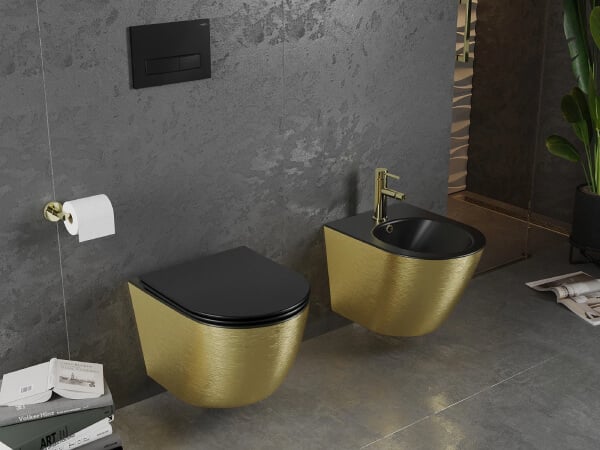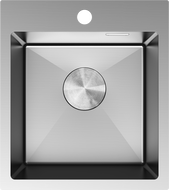
Connecting water to the toilet frame is the most important step in installing a modern toilet. Proper execution of this process guarantees not only trouble-free operation of the flush mechanism, but also comfort of use and an aesthetic appearance of the bathroom. Do you want to know how to properly install a toilet frame to enjoy its functionality for many years? Read our guide – discover step by step how to install contemporary bathroom fixtures.
What will you learn from this article?
Do you know that properly connecting water to the toilet frame not only affects its functionality, but also improves the aesthetics of the bathroom? In this article, you will learn how to properly install a Geberit system. Here is what else you will discover:
- How to connect Geberit to water?
- What to pay attention to when connecting water to the toilet?
- How to properly install the flush mechanism and avoid leaks?
- What are the advantages of installing a toilet frame in your home?
Preparation for installing the toilet frame – check what you should know?
Connecting the water supply to the toilet bowl requires proper preparation and taking into account several important tasks. First of all, pay special attention to the correct installation of the bowl in the wall and the system supplying water to the sanitary fixture. Modern ceramics, such as those produced by the Mexen company, allow for elegant concealment of both the flush mechanism and the entire plumbing installation.
Types of toilet frames
Modern toilets can be found in two forms: concealed and exposed. Concealed frames, due to their construction, are hidden inside the wall. This allows for an elegant and minimalist style. The entire installation, including the flush mechanism, is discreetly hidden, leaving only the visible bowl and flush button. Exposed frames, on the other hand, are mounted externally, which is a practical solution in the event of structural limitations or the desire for a quicker installation.
Each of these systems meets different aesthetic and functional needs, offering a wide choice for every type of interior.
Additional features of toilet frames – e.g. odor removal system
Connecting water to the toilet frame is a key step that determines the functionality of the entire system. Properly installed connections ensure trouble-free operation of the flush and an aesthetic appearance of the bathroom. Thanks to modern solutions, such as washlet toilets or odor removal devices, you can significantly enhance user comfort. Washlet toilets offer additional hygienic features while odor removal systems effectively improve air quality in the bathroom, which translates into a more pleasant experience during everyday use.
Modern toilet bowls and their installation – what else should you know?
Before starting the installation, make sure you have access to water connections and the right tools, such as a wrench and a level. Carefully check the dimensions of the selected construction to ensure it fits the dimensions of the toilet and the technical specifications of the manufacturer.
Installing bathroom fixtures starts with placing the frame of the toilet in the correct location. Typically, this is inside a sturdy wall that can support the weight of the toilet bowl and the entire installation. At this stage, you must ensure that it is stable, as it will be the one sustaining your load daily.
Remember that all necessary connections, including the water supply to the toilet, should be made immediately before the installation of the toilet frame. It is also necessary to install the flush button at the appropriate height. Determine the location on the wall before you start working.

Preparing water connections for the toilet frame
Mounting the bowl into the wall starts with connecting it to the water supply. An important element of the installation in this case is standard piping, which must meet several requirements.
First and foremost, due to the bathroom environment, the pipes must be resistant to moisture, water action, and corrosion. It is best to choose those made from durable materials, such as PVC or HDPE. Additionally, they must also be sufficiently resistant to mechanical loads, just like the frame itself.
Important installation principles:
- Fitting diameter – pipes must have a diameter suitable for the conduits to avoid difficulties during installation and ensure proper water flow.
- Connection tightness – ensure all connections are well fitted to prevent any potential water leaks.
Also, remember to thoroughly read the manufacturer's instructions to ensure that the entire installation goes smoothly, and the water flows efficiently.
Connecting water to the toilet frame – what needs to be done?
Are you wondering how to get water to the toilet? When connecting it to the toilet frame, it is essential to include the connection of the drainage pipe to the flush mechanism. A proper water connection to the Geberit system is the key to success. Therefore, you need to properly cut and adjust the length of all conduits to ensure they are sealed. Therefore, during installation work, use high-quality seals and silicone, ensuring that each installation element is correctly secured.
The process of installing the toilet frame – analyze the size of the room
First, it is important to choose the right installation location. Make sure the location aligns with the installation plan and that necessary distances from the floor, other sanitary fixtures, and walls are maintained. It is also worth checking if the room is well-ventilated, as this influences comfort of use and the longevity of the installation.
A simple way to an elegant bathroom – installing the toilet frame
Installing the toilet frame differs depending on the type of wall it is intended to be mounted in. In the case of brick or concrete walls, it can be securely anchored without additional reinforcements. However, for gypsum board walls, which are less sturdy, it is essential to use a reinforced frame that provides adequate load-bearing capacity and stability, especially in areas susceptible to large loads, such as where the toilet bowl is mounted.
Additional tips to streamline the process of mounting the toilet:
- Check connection tightness – ensure that all pipe connections and fittings are appropriately sealed. Properly installed elements allow to avoid water leaks.
- Ensure the correct placement of the bowl, remember, the flush is also important – adjust the height of the toilet bowl and flush button for the convenience of the household members. Read the manufacturer's recommendations.
- Conduct a test – after completing the toilet installation, perform a water flow test to ensure everything functions correctly and that the bowl is not leaking.
- Mind the aesthetics – make sure that all installation elements are discreetly hidden.
What benefits does proper water connection to the toilet frame provide?
Proper installation of a wall-hung toilet bowl guarantees not only comfort but also a significant aesthetic and functional enhancement to the bathroom. Thanks to modern solutions employed by contemporary bathroom fittings manufacturers, you can easily add numerous conveniences in the bathroom, such as a washlet toilet or an odor removal device.


















